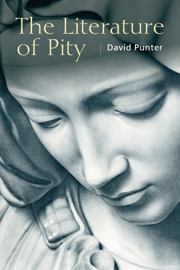Book contents
- Frontmatter
- Contents
- Plates
- Preface
- Acknowledgements
- 1 Distinguishing Pity
- 2 Pity and Terror: The Aristotelian Framework
- 3 Pietà
- 4 Shakespeare on Pity
- 5 The Eighteenth Century
- 6 Blake: ‘Pity would be no more …’
- 7 Aspects of Victoriana
- 8 Chekhov and Brecht: Pity and Self-Pity
- 9 ‘War, and the pity of War’: Wilfred Owen, David Jones, Primo Levi
- 10 Reflections on Algernon Blackwood's Gothic
- 11 Pity's Cold Extremities: Jean Rhys and Stevie Smith
- 12 Reclaiming the Savage Night
- 13 ‘Pity the Poor Immigrant’: Pity, Diaspora, the Colony
- 14 Lyric and Pity
- After Thought: Under the Dome
- Notes
- Bibliography
- Index
10 - Reflections on Algernon Blackwood's Gothic
Published online by Cambridge University Press: 05 September 2014
- Frontmatter
- Contents
- Plates
- Preface
- Acknowledgements
- 1 Distinguishing Pity
- 2 Pity and Terror: The Aristotelian Framework
- 3 Pietà
- 4 Shakespeare on Pity
- 5 The Eighteenth Century
- 6 Blake: ‘Pity would be no more …’
- 7 Aspects of Victoriana
- 8 Chekhov and Brecht: Pity and Self-Pity
- 9 ‘War, and the pity of War’: Wilfred Owen, David Jones, Primo Levi
- 10 Reflections on Algernon Blackwood's Gothic
- 11 Pity's Cold Extremities: Jean Rhys and Stevie Smith
- 12 Reclaiming the Savage Night
- 13 ‘Pity the Poor Immigrant’: Pity, Diaspora, the Colony
- 14 Lyric and Pity
- After Thought: Under the Dome
- Notes
- Bibliography
- Index
Summary
There is a great deal that could be said about the relations between pity and Gothic; indeed, a radical view would suggest that the longstanding association between terror and Gothic has been in part a cover story which places us as readers in positions of power – identifying, for example, with the hero/villain – rather than allowing us to share in the no doubt pitiable plight of the victim/heroine. But in this chapter I want to reflect on only one writer, and a writer who might indeed be seen as somewhat athwart the Gothic mainstream: Algernon Blackwood. Blackwood is still comparatively little known, despite having been one of the best-known writers of supernatural tales of his time, and some introduction is no doubt necessary. He was born in 1869 and died in 1951, and it has been said that he was one of the greatest English writers of ghost stories and supernatural fiction. That is not my comment but one made by H.P. Lovecraft, and it perhaps provides a rare opportunity to agree with something the egregious Lovecraft said. He (Blackwood) was also a writer of children's stories and novels; he was a traveller, particularly in Canada, where some of his best-known stories are set; a sometime newspaper reporter and factory owner; and he had a vast range of spiritual interests, ranging from Buddhism and Hinduism to the Order of the Golden Dawn.
- Type
- Chapter
- Information
- The Literature of Pity , pp. 107 - 118Publisher: Edinburgh University PressPrint publication year: 2014



